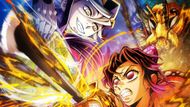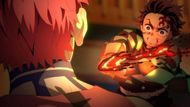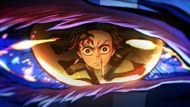When I sat down in the theater to watch Demon Slayer Infinity Castle, I knew I was stepping into one of the most anticipated anime films of the decade. As a long-time fan of both the manga and the anime, my expectations were sky-high. The opening moments instantly pulled me in.
The Infinity Castle itself is a visual spectacle, a sprawling, otherworldly maze that seems alive, shifting in impossible directions, swallowing the Demon Slayer Corps whole. Seeing Tanjiro and the Hashira get plunged into Muzan’s domain made my heart race. This is no longer the warm-up act; this is the war.

As the first part of a trilogy adapting the final arc of Gotouge’s manga, the stakes were clear: everything was building toward the ultimate confrontation with Muzan Kibutsuji. And I’ll admit, the scale and atmosphere were intoxicating. I felt like I was watching the characters I’ve grown attached to finally cross into enemy territory for the last time.
The heart of Demon Slayer Infinity Castle for me was the battle against Akaza. Tanjiro and Giyu facing him together brought closure to a fight that’s been brewing since Mugen Train. Akaza isn’t just another villain; he’s a tragic mirror of the humans he once loved and failed to protect.
Disclaimer: This article has spoilers from the Demon Slayer Infinity Castle movie. Reader's discretion is advised.
Animation was a feast for the eyes

If there’s one thing Demon Slayer Infinity Castle gets undeniably right, it’s the production quality. Ufotable has once again set the gold standard for anime visuals. The animation is absurdly polished, glowing, breathing techniques, slicing through the darkness, demons twisting and contorting in horrifying detail, and backgrounds that feel like fine art brought to life.
The fights are kinetic, with the camera whipping and diving through impossible angles. During the Akaza vs. Giyu and Tanjiro fight, in particular, I found myself gripping the edge of my seat. It wasn’t just fluid motion; it was choreographed poetry, every clash of blades bursting with emotion.
Where the movie stumbled: pacing and structure

Now here’s where my love for Demon Slayer Infinity Castle started to falter. The movie is essentially eight anime episodes stitched together, and it shows. Instead of feeling like a film with a clear arc, it plays more like a very long binge session.
Some flashbacks felt essential, but others dragged. By the time we hit the final hour, the pattern was exhausting. In manga form, these interludes are easier to digest; I can breeze through panels at my own pace. But in a film, with voice acting stretching every moment, they became drawn-out and heavy-handed.
One major criticism I have is how the Demon Slayer Infinity Castle movie did not give the audience time to process and grieve the deaths of some key characters, nor let us celebrate Zenitsu single-handedly defeating an upper moon. In my opinion, if the movie had slightly readjusted the plotline, it could have given these two major storylines to shine, and it could have elevated the tension in Battle Friends.
I couldn’t shake the feeling that this arc would have worked better as a TV season. Each fight could’ve been its own episodes, giving viewers a chance to breathe between the emotional gut-punches. Instead, the film tried to condense everything into one 2.5-hour package, and the seams were visible.
The missing faces

Another drawback was the absence of several fan-favorite characters. As it stands, some characters like Inosuke, Muichiro, and Himejima barely get meaningful moments, which makes the pacing feel uneven and leaves parts of the story underexplored.
Of course, I know this is only part one of a trilogy, and their moments are coming. Still, I left the theater feeling like too much weight was placed on a handful of battles while others were barely touched.
For a story that’s meant to be the culmination of everything, I wanted a stronger sense of the Corps as a whole moving toward their final stand. Instead, Demon Slayer Infinity Castle felt more like a series of isolated boss fights.
The soap opera of Demon Slayer

Something I noticed and honestly laughed about was the sheer amount of internal monologue. Every character narrates their thoughts mid-battle, explaining techniques, strategies, and emotional baggage. In most films, this would be jarring, but in anime, it’s tradition. Here, it bordered on soap opera levels of drama.
Did it always work? Not really. There were moments where I wished the story would just show instead of tell. But at the same time, this heightened drama is part of Demon Slayer’s identity. It’s why the fights feel so emotional because the characters are constantly revealing their fears and hopes in real time. I rolled my eyes for a few moments, but I also couldn’t deny that it added weight to the action.
Final thoughts on Demon Slayer Infinity Castle

For manga readers, the Demon Slayer Infinity Castle movie may feel faithful and satisfying, a respectful adaptation of critical chapters. For anime-only viewers like me, however, the constant start-stop rhythm leaves the film uneven. When the story clicks, it soars. When it lingers too long, it drags.
In short, Demon Slayer Infinity Castle is an essential watch for fans, but not the franchise’s strongest outing. It’s a great movie trapped inside a good one, weighed down by indulgence in flashbacks. If Ufotable can strike a tighter balance in the next two films, this trilogy could still go down as one of the greatest anime finales ever made.
